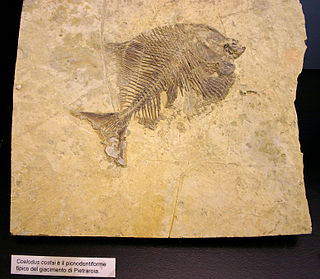
The Green River Formation is an Eocene geologic formation that records the sedimentation in a group of intermountain lakes in three basins along the present-day Green River in Colorado, Wyoming, and Utah. The sediments are deposited in very fine layers, a dark layer during the growing season and a light-hue inorganic layer in the dry season. Each pair of layers is called a varve and represents one year. The sediments of the Green River Formation present a continuous record of six million years. The mean thickness of a varve here is 0.18 mm, with a minimum thickness of 0.014 mm and maximum of 9.8 mm.

Coelodus is an extinct genus of fish in the family Pycnodontidae from the Late Jurassic to early Paleocene (Danian). Fossils of the genus have been found in:

The Mount Cap Formation is a geologic formation exposed in the Mackenzie Mountains, northern Canada. It was deposited in a shallow shelf setting in the late Early Cambrian, and contains an array of Burgess Shale-type microfossils that have been recovered by acid maceration.

The Mancos Shale or Mancos Group is a Late Cretaceous geologic formation of the Western United States.
![Tonto Group Geologic formation in "[[Grand Canyon]] region, United States](https://upload.wikimedia.org/wikipedia/commons/thumb/2/2f/Grand_Canyon-Mather_point.jpg/320px-Grand_Canyon-Mather_point.jpg)
The Tonto Group is a name for an assemblage of related sedimentary strata, collectively known by geologists as a Group, that comprises the basal sequence Paleozoic strata exposed in the sides of the Grand Canyon. As currently defined, the Tonto groups consists of the Sixtymile Formation, Tapeats Sandstone, Bright Angel Shale, Muav Limestone, and Frenchman Mountain Dolostone. Historically, it included only the Tapeats Sandstone, Bright Angel Shale, and Muav Limestone. Because these units are defined by lithology and three of them interfinger and intergrade laterally, they lack the simple layer cake geology as they are typically portrayed as having and geological mapping of them is complicated.

The Sonyea Group is a geologic group in the northern part of the Appalachian Basin. It preserves fossils dating back to the Devonian period.
The Graford Formation is a geologic formation in Texas. It preserves fossils dating back to the Carboniferous period.
The Wolf Mountain Shale is a geologic formation in Texas. It preserves fossils dating back to the Carboniferous period.
The Helms Formation is a geologic formation in Texas and New Mexico. It preserves fossils dating back to the Chesterian (Serpukhovian) Age of the Carboniferous period.

The Hueco Formation is a geologic formation in west Texas and southern New Mexico. It preserves fossils dating back to the early Permian period.

The Gros Ventre Formation is a geologic formation in Wyoming, USA. It preserves fossils dating back to the Cambrian period. The Gros Ventre consists of three main members; the Wolsey Shale, the Death Canyon Limestone, and the Park Shale.

The Red House Formation is a geologic formation found in the Caballo Mountains in New Mexico. It preserves fossils dating back to the middle to late Pennsylvanian.

The Gray Mesa Formation is a geologic formation in New Mexico. Its fossil assemblage dates the formation to the Moscovian age of the Pennsylvanian.

The Contadero Formation is a geologic formation in the San Andres Mountains of New Mexico. It preserves fossils dating back to the late Devonian period.
The Wood Canyon Formation is a geologic formation in the northern Mojave Desert of Inyo County, California and Nye County and Clark County, Nevada.
The Mulholland Formation is a Pliocene epoch geologic formation in the Berkeley Hills and San Leandro Hills of the East Bay region of the San Francisco Bay Area, California. It is found within Alameda County and Contra Costa County.

The Mint Canyon Formation (Tm) is a Miocene geologic formation in the Sierra Pelona Mountains of Los Angeles County, southern California. The formation preserves fossils dating back to the Middle to Late Miocene.

The Fusselman Formation is a geologic formation in westernmost Texas and southern New Mexico. It preserves fossils dating back to the early Silurian period.






![Tonto Group Geologic formation in "[[Grand Canyon]] region, United States](https://upload.wikimedia.org/wikipedia/commons/thumb/2/2f/Grand_Canyon-Mather_point.jpg/320px-Grand_Canyon-Mather_point.jpg)




